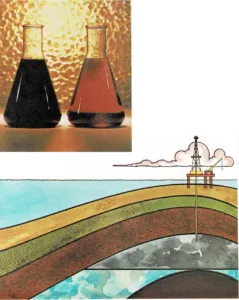Black gold
The oil that keeps your bicycle from squeaking and the gasoline that
keeps your parents’ car running both come from deep in the earth’s
crust. Both began as a thick black liquid found in big pools between
layers of rock.
Oil is not a mineral. Like coal, it was made from things that were once
alive. Oil is found in places where there were seas and oceans millions
of years ago. Tiny plants and animals lived along the shores of these
seas, just as they do today. When these creatures died, their bodies
drifted down to the sea bottom. Over millions of years, billions of
these tiny dead creatures formed deep piles.
Sand and mud settled over the piles of dead creatures and formed thick
layers. Slowly, these layers were squeezed together by their own weight
and the weight of the water pressing down on them. They were squeezed so
hard they became layers of rock.
Scientists think that the heat and weight of the rock, pressing on the
piles of dead, rotting plants and animals, turned them into drops of
oil.
Today, people drill down through many layers of rock to find pools of
oil. From oil we get gasoline to run the engines of cars, trucks, and
tractors. Many kinds of plastics and other things are made from oil. And
it is used to heat houses, factories, and schools.
Because oil was first found seeping up between rocks, it was called
petroleum—from two Latin words meaning “rock oil.” Today, petroleum is
usually just called oil. But it is so important, and worth so much, it
has been nicknamed “black gold.”
crude and refined oil

Crude oil, or petroleum, is often called “black gold.” This is because
the valuable crude oil is thick and black when it comes out of the
ground. It is then sent to a refinery to be made into fuel oil,
gasoline, kerosene, and other products.

